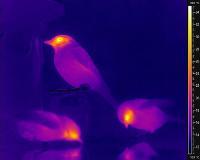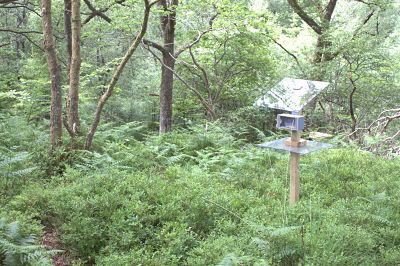Taking stress out of measuring stress: how to get the images you need
Published: 16 November 2015
Being stressed is a feeling we only know too well. And we try our best to avoid it. It is also something that we must avoid to inflict on animals we use and we care for. But how do we know that an animal is stressed?
Being stressed is a feeling we only know too well. And we try our best to avoid it. It is also something that we must avoid to inflict on animals we use and we care for. But how do we know that an animal is stressed? We can't simply ask them. Instead we need to resort to some measure that probe some physiological pathways involved when an animal is stressed. Typically we can assess the level of stress hormones.
Yet in order to do so we typically need to catch and handle the animal and take a small blood sample. Another physiological stress response requires to measure changes in core body temperature. We can measure this basically by sticking a thermometer up ...., well an uncomfortable place. So the problem is that these rather invasive measures themselves are stressful, and we need to take the stress out of measuring stress. A non-invasive alternative possibility to assess stress that emerges is the measurement of skin temperature. You can watch this video produced by GIST to learn more about the rationale of measuring skin temperature.
 So far, so good. But how do you get skin temperature without stressing the animal? Well, easy enough by recording thermal images that record the infrared radiation reflected from a surface and is proportional to that body's temperature. The great thing is that you can do that from a freely moving animal. So you can actually record changes in surface temperature in real time.
So far, so good. But how do you get skin temperature without stressing the animal? Well, easy enough by recording thermal images that record the infrared radiation reflected from a surface and is proportional to that body's temperature. The great thing is that you can do that from a freely moving animal. So you can actually record changes in surface temperature in real time.
The tricky bit of the story starts now. How to get really good images that allow accurate measurements of surface temperature? The best window of a bird to its surface temperature unaffected by plumage is the area around the eye. That is normally only a few pixels on an image. So if the image is not right in focus the warmer area around the eye will blur with cooler regions further away from the eye and there won't be an accurate temperature measurement.

We decided to approach this as a wildlife photographer would do: let the animal position itself in an ideal position in front of the camera and then we just need to press the button. So we built a little arena that brings the bird exactly the right distance in front of the camera where the eye is as large as possible and perfectly in focus and we eliminate as much as possible influence from direct solar radiation - although the latter is usually a minor problem in our Scottish climate. Then the camera will just shoot away a sequence of good images of your bird. If the bird remains undisturbed that surface temperature should change little and provide a baseline temperature. If the bird gets disturbed, then the surface temperature will suddenly drop and subsequently recover. A thermal video can record the exact dynamic of those changes rather than taking some arbitrary snapshots during that process as we rely on for hormone measures.
But that is not yet what we can use for a rigorous analysis. Now the tedious part of the work begins to extract the temperature from a specific point of the body for thousands of images. And not all of them are sufficiently good; the bird might have tilted their head away or just have blinked that all reduces the escorted temperature. All those images need to be filtered out. Some of this has to be done manually but fortunately there are some shortcuts where statistics can save us a lot of work. The exact methodology is now described in our paper published in the Journal of Visualised Experiment, and even better – if you don’t want to read a methods paper, you can watch it as a video.
After all of this work has been done we get a very clear signature of a disturbance when the surface temperate drops below the baseline temperature that tells us that the bird was stressed. It does not yet tell us how stressed the bird is, this has been the subject of another study and another blog coming soon – watch this space.
First published: 16 November 2015

